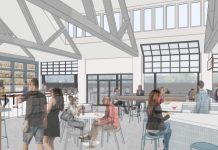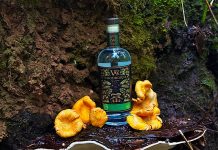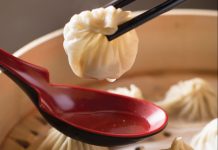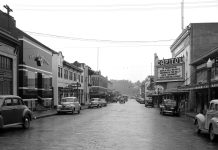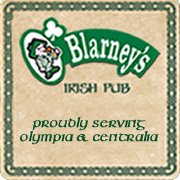At the turn of the 20th century most people bought their bread every day or made it themselves. Bakeries promoted themselves as the modern and scientific replacement for home baking. The Daylight Bakery was one of the most successful bakeries in Olympia early history.
Daylight Bakery Grand Opening, 1919
In 1919 Capital City Creamery’s Frank R. Klumb decided to open a new bakery at 307 East Fourth Avenue, next to the Rex Theater. Naming it the Daylight Bakery, he hired William Shuntz as manager.
Doors opened on Friday, July 18. Three hundred free loaves were given away. Tasty and “fresh from our sanitary ovens,” ads promised that the bakery’s signature “Peerless Bread” was “the bread that made mother quit baking.” Customers could watch their bread being produced alongside pastries and other sweet treats.
In January 1920 Klumb sold the store to Roy J. Langford and Oscar W. Ridder. Both experienced bakers, they began selling their bread through local grocers as well as in Shelton and Nisqually.
The “Home of the Wizard Bakers” replaced Peerless Bread with their own specialty, “Butter Krust” bread in 1922. Made from a blend of patent flour, eggs, malt, yeast, pure cane sugar, vegetable shortening and artesian well water, Butter Krust bread came in pan, health, graham, and split top varieties. “Taste Tells the Tale” became the bakery’s motto.
In 1921 baker George Martell, former manager of the Union Mills Hotel, bought out Langford’s interest, becoming co-owner. For 48 days in 1923 the store gave away colorful bird pictures with their loaves. With a new card every day, customers were encouraged to collect them all, like Pokémon cards.
After Martell left, Ridder sold the business to Lloyd R. Proctor of Idaho in 1925. Proctor continued to sell Butter Krust Bread. He tried to replace it with his own Proctor’s Bread in 1931, but popular demand brought Butter Krust back.
However, he continued to sell Proctor’s Bread, available in white and whole wheat. It was special. “The bread that’s already sliced,” as the ads boasted. But while local newspapers scoffed at the laziness of “present-timers” for not wanting to bother slicing their own bread, it offered new convenience. School classes and scout troops often visited the Daylight Bakery to see the exciting new process—and enjoy free treats.

Daylight Bakery in Olympia Through the Great Depression
During the Great Depression people struggled to afford groceries. In December 1929, a burly man shoved a pistol into night baker Kurt Koehler’s ribs and demanded cash to feed his starving family. The store did not have any money, so Koehler gave him a bag of pastries instead.
The Daylight Bakery was producing 300 loaves a day in 1930, even as sales struggled. Bakers experimented with new offerings to attract customers, such as take-and-bake baking powder biscuits and “Rays-N-Date” bread. Their “Roses in Snow Cake” had an actual stemmed rose atop a white frosted layer cake!
Worried about out-of-town competition, the Daylight Bakery urged customers to shop local. “What Olympia Bakes, Makes Olympia,” their ads declared. The store also started selling bread to local soda fountains. They endeared themselves to legions of children by providing free Mickey Mouse cookies and mini birthday cakes for Mickey Mouse Club meetings at the Capitol Theater.
The bakery also made headlines when it provided a 500-slice cake (for female patrons only) for the sixth anniversary party of the Liberty Theater in 1930. It was the biggest cake ever baked in Olympia the bakers bragged.

World War II Brought New Challenges to the Daylight Bakery
After Proctor died of a heart attack in 1942, his widow Nora (who had co-run the bakery), sold it to Phil S. Brown of Tacoma. He ran the bakery with his wife Beth.
The next year, Brown sold the bakery’s wholesale division to Jordan’s Baking Company of Olympia. “Fresh-As-A-Daisy” bread now replaced the Daylight Bakery’s bread on grocery store shelves.
Brown continued to operate the retail store on Fourth Avenue. An excellent businessman, he even served as chair of the Retail Board and president of the Olympia Chamber of Commerce.
The war brought rationing and shortages. The Daylight Bakery began selling milk bread, potato bread and soybean bread. They made fewer special-order cakes and closed on Mondays. To save metal knives, the government banned pre-sliced bread.

Daylight Bakery in the Post War Era
After the war, the bakery started awarding a cake to the kid whose dog had the most spots at the annual Pet Parade.
Phil Brown sold the store to Oscar Ulbricksen of Sumner in 1947. Brown and business partner Boyd Andrus later opened the Olympia Oyster House restaurant.
In 1948, Lewis T. Gilmour bought the bakery. Renamed Gilmour’s Daylight Bakery, its new motto was “Every Bite a Pure Delight.” One of their specialties was split-topped “Mrs. [Hellen] Gilmour’s Butter Flavored Bread.”
The store now focused on specialty breads and desserts, including wedding cakes. Their cakes, cookies and doughnuts proved popular, especially the Scandinavian ones.
R.E. “Bob” Barnhart purchased the store in 1952. But times had changed. Local bakeries struggled to compete with national companies. Barnhart’s Daylight Bakery tried to attract customers with weekend specials like one-cent cookie sales. He also began selling dairy products and eggs.
It was not enough. Barnhart closed the Daylight Bakery in early December 1953. For 34 years the Daylight Bakery was one of Olympia’s leading businesses. Its bread and pastries graced local tables for ordinary meals and special times alike. This community focus is continued by Olympia’s local bakeries today.
Read more Thurston County history articles here.





